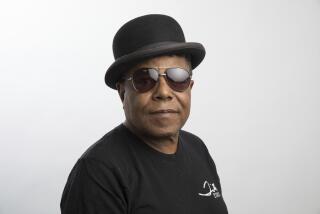Swan Song Near for Student Orchestra
Waiting to conduct a rehearsal of his orchestra, 77-year-old Cesare Pascarella was sitting in his studio at the California Institute of the Arts’ Valencia campus when a teen-age musician burst into the room. The boy announced that his brother, a cellist, had cut a finger and would be absent that day.
“Call him and tell him to come anyway,” Pascarella shouted, his face reddening and his thick hand waving the boy out of the room. “Tell him he can play with four fingers! Tell him!”
Pascarella has been treating high-school-age musicians in the CalArts Youth Music Group with steely professionalism for 15 years, but he was particularly eager to have the injured cellist heed his stern advice last week: only 11 musicians were ready to start the rehearsal, which once would have included 50.
Because of such dwindling numbers--along with insufficient funds and, in the eyes of some, an inadequate commitment to training performers--the CalArts music program, which has trained hundreds of Los Angeles youths, some of whom have gone on to celebrated careers as musicians, is scheduled to expire in three weeks.
Program Ends Aug. 8
The injured cellist stayed home, as did other musicians who have been looking for other playing opportunities since the CalArts School of Music, citing budgetary constraints, announced that Aug. 8 would be the last day of the program.
But the program may not die easily.
April’s announcement by Frans van Rossum, dean of CalArts music school, spurred students’ parents to form a committee to explore the possibility of running the program as an independent, nonprofit association. Faculty members have criticized the administration’s decision. And, at a meeting in April, five public school district superintendents from the Santa Clarita Valley said they might help the parents by promoting the program among their students and helping to write grant applications for a private association.
“Your orchestra in your typical high school is never as strong as your band, so you look to outside programs, such as the one the CalArts orchestra provided,” said Hamilton Smyth, superintendent of the William S. Hart High School District. He said most classical-music programs in area public schools died in the wake of Proposition 13.
Paternalistic Style
The Italian-born Pascarella has run the program from its start with a paternalism reminiscent of maestros of a bygone era. Combining college-level orchestral training with chamber music and theory classes lasting all day every Saturday, the program has served young musicians such as Sherman Oaks’ Paul Neubauer, who went on to become principal violist of the New York Philharmonic.
Van Rossum said this week that the school is looking for money to pump life back into the program, but that there is no help in sight. CalArts’ president has said he does not believe there will be any money for several years.
“We’re trying to keep this available for young people,” said David Bozman, of Canyon Country, who has a 13-year-old son in the program and who, with his wife, Sue, is leading the parents’ campaign. “We’re going to do that through whatever method is available to us, whether it’s through CalArts or through a private foundation.”
The Bozmans are encouraged by the revitalization of what is now the Glendale Symphony Youth Orchestra, achieved largely through the efforts of players’ parents. The orchestra appeared to be playing its final notes in 1982 when it was called the Foothill Youth Orchestra. But it became an affiliate of the Glendale Symphony Orchestra Assn., which helped the parents set up a board of directors and obtain nonprofit status.
Number of Players Has Grown
Aided by community donations for scholarships, the number of players has grown to between 50 and 60 performers, up from 20 before 1982.
In trying to persuade CalArts to revive its program, Bozman and other parents point to the many examples of former CalArts Youth Music Group members who later attended CalArts as college students, and from there began successful careers.
The 22-year-old Neubauer, one of the youngest first-chair players in the history of major orchestras and a rising star in the classical-music world, left the program for New York’s Juilliard School after six years under Pascarella’s direction. Erica Duke, who grew up in North Hollywood and is now a busy free-lance cellist in Los Angeles, selected CalArts after several years in the youth program.
But, even as the program has produced successful professional musicians, the enrollment has been declining, from about 50 youths a semester in the 1970s to about 20 a semester in the last few years. Participants say the decline has come during a time of diminishing emphasis on classical-music training in public schools. But they also say that, when the program needed additional financial and promotional support from CalArts, the school did not offer much help.
“I think they gave up without a fight,” Duke said. “Very little has been done to support the program. Communities no longer have strings programs in the schools. But youth orchestras historically have had difficulties getting enough members. You have to promote this kind of thing.”
Pascarella said his greatest need is scholarship money for students who cannot afford the program’s fees: $120 for a 15-week semester and $160 for the 20-week summer session.
Van Rossum acknowledged that, in recent years, the institute has not given the program the kind of support it needed to flourish. “We are aware that, although the youth program did well over the years, that it needs a fair amount of money to do better. That money is not available,” he said.
Budget ‘Not Enough’
The institute has spent about $28,000 annually on the youth program, Van Rossum said. He said that covers part of Pascarella’s salary and the cost of a teaching assistant who gives classes in music theory. (Pascarella said he believes the $28,000 figure is exaggerated). Van Rossum said the annual budget at the CalArts School of Music--one of the five schools within the parent institute--is $1.2 million, “not enough to cover the most essential necessities.”
CalArts’ music school is noted for placing more emphasis on composition than most music schools. There are five full-time instrumental teachers at the school--and seven full-time composition teachers. In the 1984-85 school year, according to the registrar’s office, CalArts had 159 students at the School of Music, 104 of them undergraduates and 55 graduate students--including 37 composition students.
Pascarella has suggested that the decision to end the orchestra may be related to CalArts’ emphasis on composition. He said the only orchestral training offered to CalArts’ college-level instrumentalists is a chamber orchestra that meets for one month each semester. As a result, about 20 CalArts students have performed with the youth orchestra at each of the five concerts it gives at the school each semester.
“I have felt that performers were not being catered to adequately at CalArts,” said Duke, a part-time cello teacher at the school. “I think they are trying to come up with a highly polished image of the contemporary music school they want CalArts to be. But composers learn from working with performers.”
‘Balanced Attitude’
Allan Vogel, the principal oboist with the Los Angeles Chamber Orchestra and full-time teacher at CalArts, said that Van Rossum has a “balanced attitude” toward performers, but suggested that the school has a tendency to spend too much money on equipment used in electronic composition. The school has four electronic composition studios filled with the advanced equipment.
Composers from around the country come to CalArts to use the studios, according to Greg Fish, a graduate composition student. Fish was working in one of the studios last week with Charles Boone, a San Francisco-based composer who said he was completing a piece funded by the National Endowment for the Arts.
“Most music schools are oriented toward performers and this is one of the few, the very few, where composers come first,” Boone said. “It is easily the most important school anywhere in the country for composers.”
Near the studio where Fish and Boone were polishing Boone’s composition, members of the CalArts Youth Music Group were playing Schubert’s “Tragic Symphony.”
Cuts Chord Short
Pascarella, who has a mustache and a head rimmed by white hair, swept the air with his baton, then motioned for the group to pause between musical phrases. The subsequent chord did not last long, before he cut it off. “You made a mistake,” he said to a violinist, sharply. “Again.”
The passage was played over.
“You still made the mistake. You know how to do it. Again.”
He sang the phrase, and the young musician imitated him on the violin, without error this time.
For those who have been a part of the group and who are fond of Pascarella, the “Tragic Symphony” was an appropriate piece for the moment. His orchestra had but the 11 musicians--two first violins, two second violins, four cellos, two horns and a flute.
Demise Called ‘Disgraceful’
“I think it’s disgraceful,” Jonathan Schwartz, a 17-year-old French horn player from Sherman Oaks, said of the group’s demise. A participant in the program for two years, he studies with a professional horn player from Woodland Hills who also was a member of the youth group. “Mr. Pascarella gets to the essence of the music and he expresses himself very well,” said Schwartz, who plans to audition for the Juilliard School.
During a break in the rehearsal, Pascarella said that more students would have attended the rehearsal if there had not been confusion over the announcement about the program’s end.
“People misunderstood the letter that Van Rossum sent out in April,” he said. “They didn’t understand that I would continue until the end of the summer and they made other plans. I will go until Aug. 8. But I have my hopes we can keep going after that. There are many people who want this to go on. I have my hopes.”
More to Read
The biggest entertainment stories
Get our big stories about Hollywood, film, television, music, arts, culture and more right in your inbox as soon as they publish.
You may occasionally receive promotional content from the Los Angeles Times.










